Nestled amidst the rugged peaks of the Himalayas, between 500 and 2,000 meters above sea level, lies fertile land that has sustained farmers for thousands of years. In our village of Ratanpur, situated roughly halfway between Kathmandu and Pokhara (google earth link), the often narrow and steep terraces whisper centuries-old tales of traditional farming, where millet, lentils, vegetables, rice, and corn once thrived.
Beyond their picturesque beauty, these rural areas of Nepal grapple with significant challenges. Traditional agriculture on such steep slopes allows for little mechanization. While the land is productive enough to feed a family, it often falls short of generating an income sufficient for the growing demands of modern society. The production costs for vegetables, fruits, and grains are simply too high to compete in the market. In search of better incomes and higher living standards, young villagers are migrating to cities or abroad. Consequently, many fields in Ratanpur lie fallow, overgrown by tall grasses and invasive shrubs (Fig. 1 & 2).
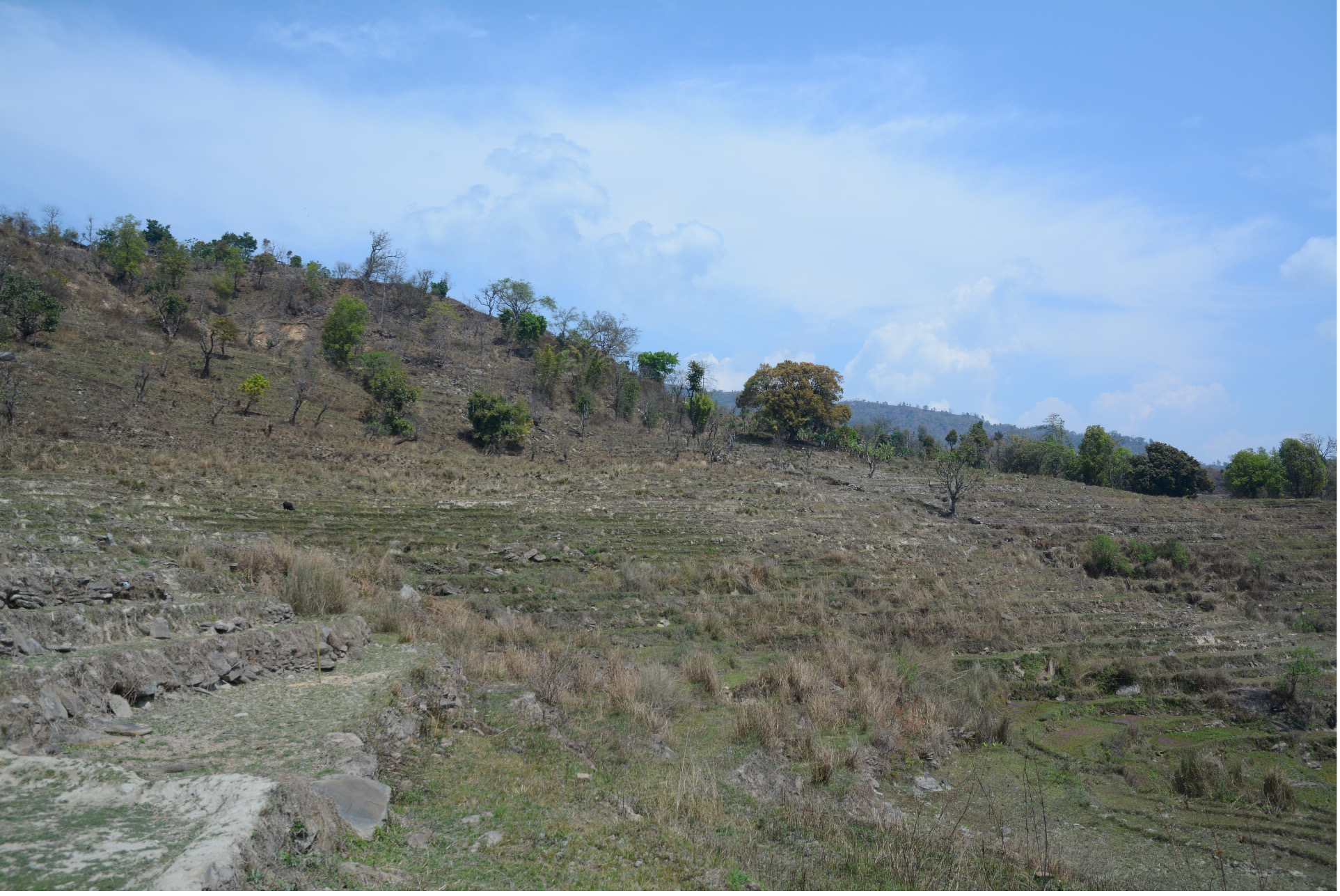
Figure 1: Steep terraced mountain slopes characterize the landscape in Ratanpur. The higher terraces are not suitable for wet rice cultivation because the rainfall is only sufficient to flood the lower fields. As a result, these higher terraces are increasingly being abandoned.
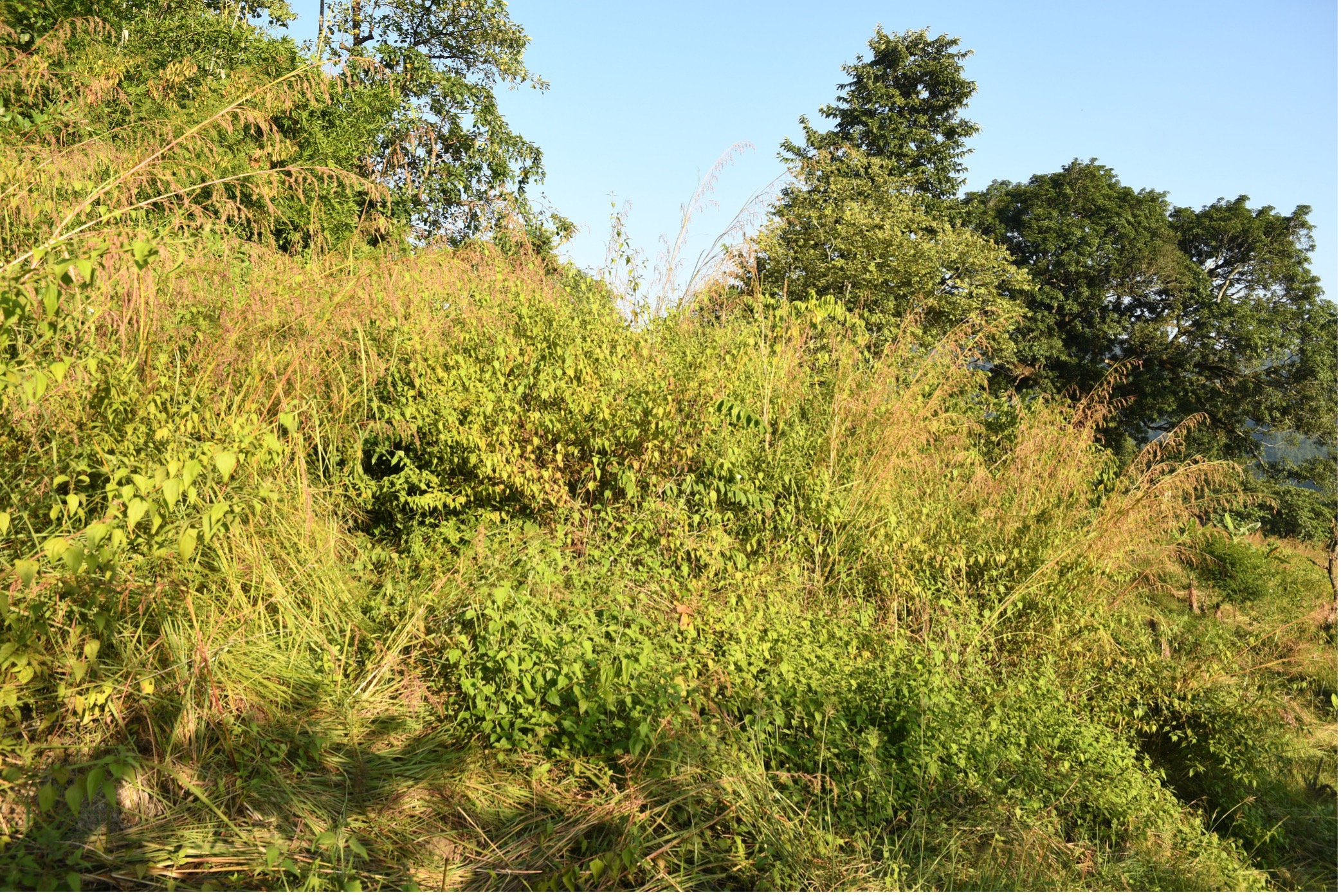
Figure 2: Depending on the fertility of the soil, the terraces become overgrown with bushes within a few years, often mixed with invasive species.
Carbon Farming Takes Root in Ratanpur
For a decade, the Ithaka Institute has partnered with the Ratanpur community, breathing new life into these landscapes. Together, we've cultivated thriving forest gardens, established robust nurseries and greenhouses, pioneered biochar-based compost production, and launched a cooperative to market high-value products like essential oils and dried fruits (as beautifully chronicled by journalist A. Joshi). Our latest, most ambitious undertaking is the Ratanpur Carbon Farming Experiment—a pioneering long-term trial designed to reveal precisely how various land-use strategies can revolutionize both carbon stocks and local incomes.
Broadly defined, carbon farming encompasses agricultural practices tailored to optimize the capture and storage of atmospheric carbon, or at the very least, reduce agricultural greenhouse gas emissions (EEB, 2021). Methods include intercropping, agroforestry, cover cropping, and the strategic application of biochar. Yet, despite their promise, real-world experience is scarce. How truly effective are these techniques? How seamlessly can they adapt to diverse local conditions? And crucially, how do they perform when woven together into comprehensive carbon farming systems? Large-scale, comparative trials of different carbon farming systems remain exceptionally rare. This is precisely why the Ratanpur Experiment was conceived—to deliver practical and scientific answers to three pivotal questions:
- How effectively do carbon farming practices align with Nepal’s mid-hill climate and unique soil conditions? (The Agronomic Dimension)
- How can deeply ingrained local farming practices and social customs evolve to embrace these innovative techniques? (The Social Dimension)
- What tangible benefits—in terms of crop production and quantifiable carbon sequestration—can the local population realistically expect? (The Economic Dimension)
Spanning a nearly 7-hectare expanse in the Ratanpur hills, nine distinct carbon farming systems are currently undergoing rigorous evaluation. Over the next three decades—and hopefully far beyond—this ambitious project seeks to identify the systems that deliver optimal carbon sequestration, maximize yields, and build the highest resilience. The Ratanpur Carbon Farming Experiment stands as a truly singular endeavor, and its findings are poised to provide invaluable guidance for successful carbon farming not only across Nepal but also around the globe.
Coffee: The Unifying Element
Every system within our carbon farming experiment shares a crucial common denominator: a consistent number of coffee trees. By anchoring our research on coffee as the main crop, we can directly evaluate how various practices—from intercropping to biochar application—impact its growth and yield. Moreover, given coffee's global significance, the insights gleaned from our Ratanpur site have the potential to benefit farming communities far beyond Nepal's borders.
Each carbon farming system combines coffee with diverse companion crops, such as fruit trees, annuals like lentils and ginger, perennial grasses, or bamboo (see Table 1). While each approach highlights a different objective—be it maximizing biochar production, diversifying farm income, or boosting carbon storage in shade trees—all show promise. However, they differ significantly in terms of labor demands, productivity, climate resilience, and carbon sequestration potential. Only a rigorous, long-term field trial like ours can genuinely assess which systems perform most effectively and are scalable under specific local conditions.
The Ratanpur Carbon Farming Experiment functions as both a research hub, a practical demonstration farm, and an education center. Its objective is to integrate scientific research with the knowledge and experience of local farmers, aiming to develop a model for sustainable land use. This model may offer insights for farmers globally, stemming from carbon farming practices developed in the Nepali hills. Local and international visitors, students, and researchers are welcome to the site.
Establishing this long-term experiment has been an ambitious journey, characterized by its share of challenges, inevitable setbacks, and exciting breakthroughs. In the following sections, I'll share some personal reflections and key observations from the initial two years of this truly unique project.
2023 and 2024: Laying the Groundwork for the Ratanpur Carbon Farming Experiment
When I first arrived in Ratanpur, it felt like stepping into a forgotten world. The terraces, overgrown with grass, lay under the warm glow of the evening sun, seemingly waiting to be revived with new life and fresh ideas. Our initial task in March 2023 was to map the land and establish plots of equal size distributed across the hillside. After lengthy negotiations, Ithaka had managed to acquire a contiguous 7-hectare tract from more than 20 families, who had mostly moved to the city long since. Crucially, none of these terraces were actively farmed at the time, ensuring our project didn't compromise local food security. The degree of overgrowth on each terrace varied considerably, influenced by how long it had lain fallow, its previous crops, and its soil moisture levels.
Bishnu Pandit, the director of the Ithaka Institute in Nepal, Anand Pokhrel, our long-time engineer and jack of all trades, and I spent countless hours walking the boundaries of the farm and discussing possible layouts for the plots. The steep, irregular nature of the terraces immediately ruled out conventional square or rectangular parcels, forcing us to adapt our design to the land's natural contours (see Figure 3).
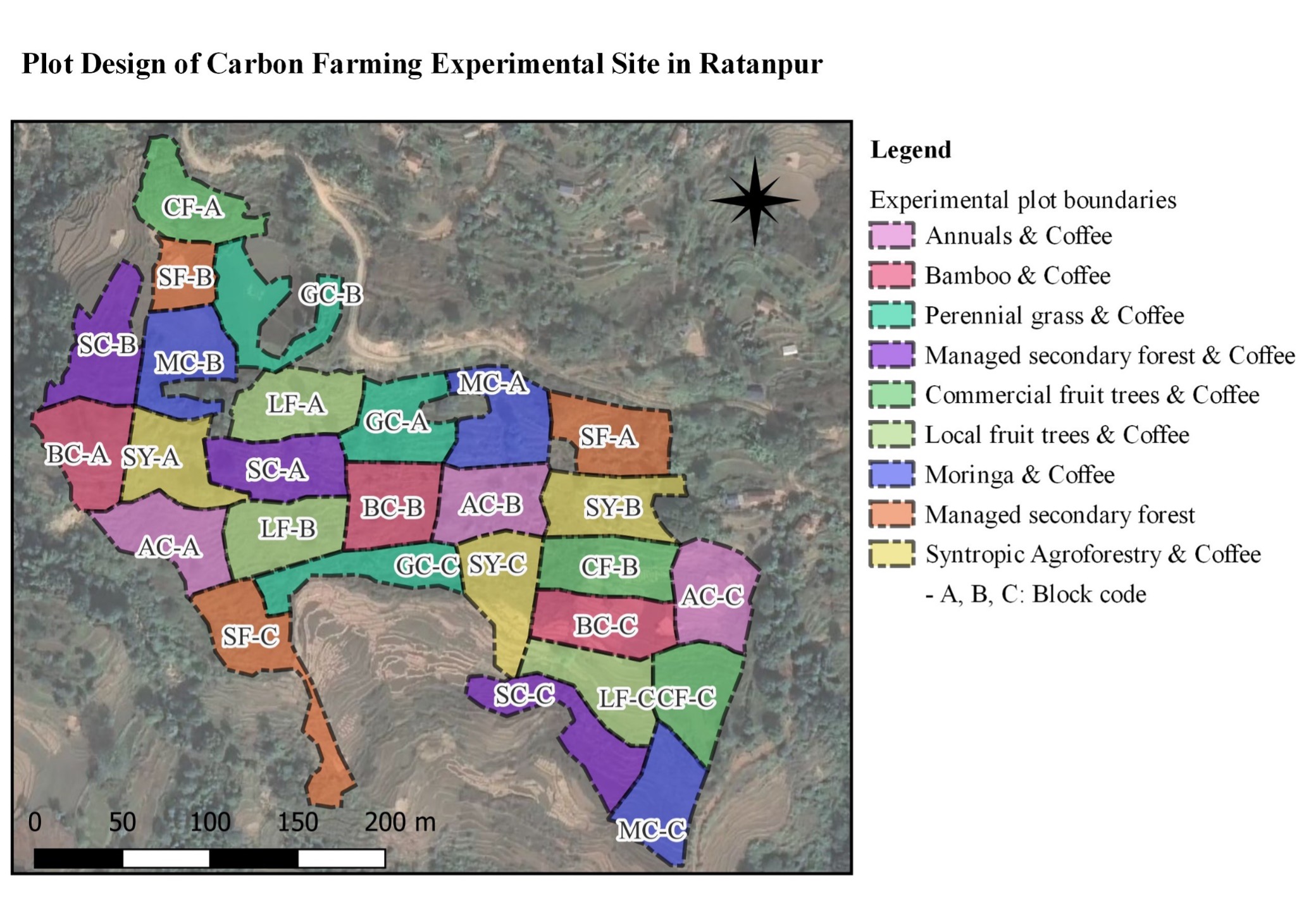 Figure 3: Map of the 27 experimental plots, each measuring 2,500 m², with boundaries following the natural contours of the terraces.
Figure 3: Map of the 27 experimental plots, each measuring 2,500 m², with boundaries following the natural contours of the terraces.
Once the overall layout of the experimental farm was finalized, we immediately began collecting soil samples to establish baseline conditions. March, being one of Nepal's driest months, meant the soil was hard and dry, making it challenging to sample down to our target depth of 60 cm. Nevertheless, with the dedicated assistance of Anand and the first three members of our carbon farming team—Ishwor, Ramchandra, and Ashwok—we successfully collected over 400 soil samples across the 27 individual plots (Figure 4).
We measured soil bulk density and analyzed the organic carbon content in more than 80 composite samples. This lab work was conducted right in our small Ithaka laboratory in the village. The biggest hurdle wasn't the analysis itself, but rather ensuring the drying oven stayed operational during frequent power outages, which required swift switches to a generator whenever the electricity failed.
These initial soil data provided key insights into the physical and chemical characteristics of each plot, helping us to adequately design the trial but also for accurately interpreting future results.

Figure 4: Soil pit for measuring bulk density at a depth of 45 cm (left), using a core sampler (center). Anand collects a sample with a “Pürckhauer” soil auger (right).
Based on the soil data and previous land use, we structured the experiment as a randomized block design. The site was divided into three equally sized blocks: A, B, and C. This setup ensured that each of the nine carbon farming systems was represented in every block, resulting in three replications per system (see Figure 3). In scientific research, such replication is crucial to account for natural variability and for reliably determining whether observed differences are caused by the systems themselves or are merely the result of chance or external factors.
Each of the 27 plots spans 2,500 square meters, the minimum area needed to realistically implement a complex carbon farming system incorporating multiple tree species.
News of the project quickly spread throughout the community, drawing many local farmers, curious about the activity on the long-abandoned fields. We organized community meetings to share our plans. Most villagers were already familiar with biochar from earlier Ithaka projects, and they were intrigued by the idea of transforming abandoned terraces into a research farm. The integration of coffee cultivation sparked considerable interest. As a relatively new crop in Nepal, coffee holds significant promise, and the idea of Ratanpur becoming a model for coffee-based carbon farming filled the community with pride. As one farmer put it, "If we can develop new coffee-growing methods here, Ratanpur could become a famous example and help other farmers improve their yields too."
Tree Establishment in 2023 (first year)
After five intense weeks in Ratanpur, I departed briefly and returned in June for the monsoon season - just in time to commence planting. Meanwhile, the local team had continued clearing invasive plants and tall grasses from the terraces. The cleared vegetation was pyrolyzed using a Kon-Tiki kiln to produce biochar. From roughly five tons of weeds, we successfully yielded one ton of biochar which was then mixed with goat manure, creating a nutrient-rich organic fertilizer that we applied directly to the root zones of the tree seedlings.
By summer 2023, our carbon farming team had expanded to seven members: Ishwor, Ramchandra, and Ashwok (who had worked with me in March), alongside Sangita, Juna, Kalpana, and Chandra Bahadur. It was a diverse group, spanning ages from 22 to 72. Most possessed extensive farming experience, while others had previously worked abroad in entirely different professions. Back in their home village, they were content to find meaningful work that allowed them to apply their practical skills.
Planting began with the arrival of the rains. Our first step involved transporting coffee and fruit tree seedlings from a trusted, albeit distant, nursery, navigating Nepal’s notoriously bumpy roads all the way to the Ratanpur field. Following a fixed layout, the coffee trees were planted with a spacing of two meters within the rows and six meters between rows. The six-meter gap between these coffee rows was then dedicated to various intercrops, which differed by system. In some, we planted fruit trees, while in others, we introduced lentils or broomgrass.
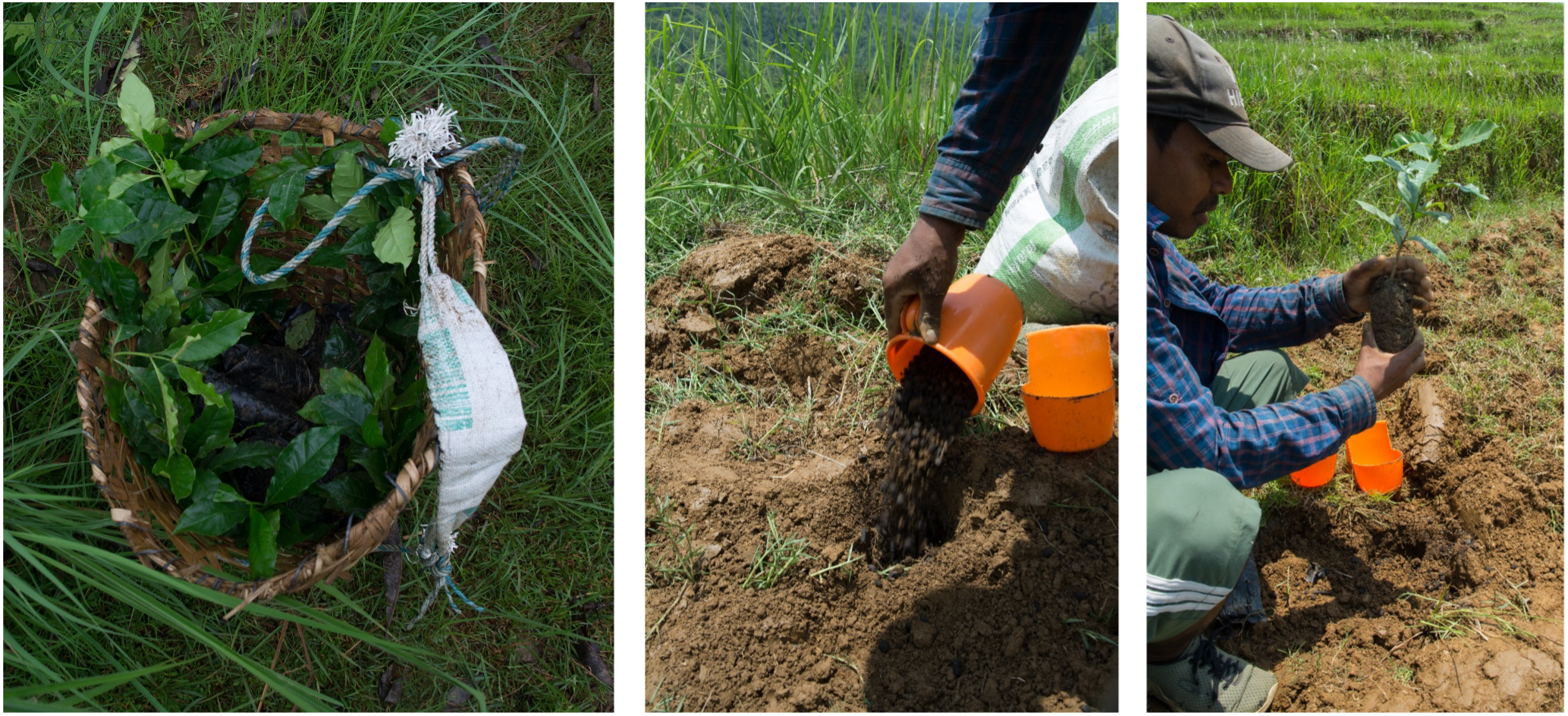
Figure 5: A traditional bamboo basket (Doko) is filled with coffee seedlings (left) and carried across the former rice terraces. In the center, a planting hole is enriched with biochar-goat manure. On the right, Ishwor carefully plants a seedling.
The steep terrain made it impractical to use tools like wheelbarrows or tractors. Instead, we relied on traditional bamboo baskets, known as dokos, to transport seedlings and fertilizer across the terraces (Figure 5). The only "fancier" piece of equipment we incorporated was a battery-powered auger, which significantly streamlined digging uniform planting holes.
To keep the planting process organized, we divided responsibilities among the team. Tasks included transporting seedlings and biochar-based fertilizer, drilling the holes, applying the fertilizer, planting the trees, and finally tagging each tree with a unique barcode for future monitoring. Over time, we streamlined the process to the point where we could complete one plot (approximately 210 coffee trees) in a single day. The only remaining bottleneck was the battery life of the auger (Figure 6).
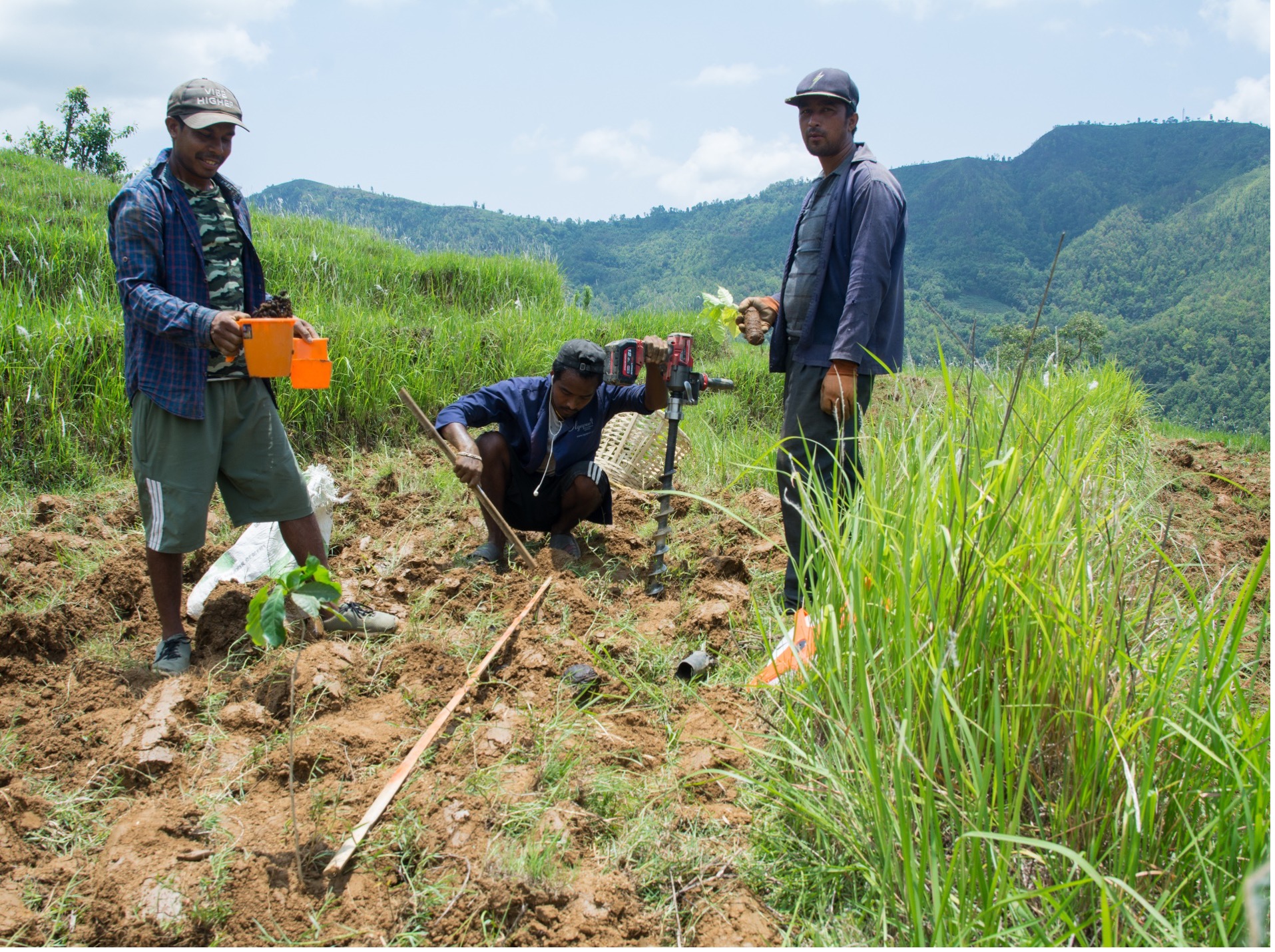
Figure 6: Ishwor (left), Ashwok (center), and Ramchandra (right) planting coffee together with our “weakest team member”, the battery-powered auger.
One afternoon, after a long day in the field, I returned to recharge another set of batteries. I noticed Chandra Bahadur, our oldest team member, was still at work. He showed me how he was meticulously crafting bamboo stakes and tying them with natural rope made from grass fibers to support the taller seedlings, which might otherwise bend or break. His remarkable care and attention to each individual tree, ensuring they grew straight, proved incredibly important. We soon entrusted him with a final quality check, ensuring every tree was properly supported and protected.
By the time my second visit concluded, we had planted 5,950 coffee and fruit trees. The team continued in August and September, establishing intercrops such as broomgrass, lentils, bamboo, and moringa.
Upon my return in October to assess the newly planted trees, the dry season's impact was evident. Despite our best efforts to water and care for thousands of seedlings across the 7-hectare site, some coffee plants displayed significant signs of stress.
To some extent, we had anticipated this challenge. Alongside each coffee tree, we had planted a fast-growing legume shrub (Tephrosia candida) to provide the shade young coffee plants typically need during their early growth. While the Tephrosia shrubs had begun to establish, the shade they offered was not yet sufficient. Consequently, we custom-built small, tepee-like shelters from bamboo and cut grasses to shield the coffee seedlings from the harsh direct sunlight (Figure 7).
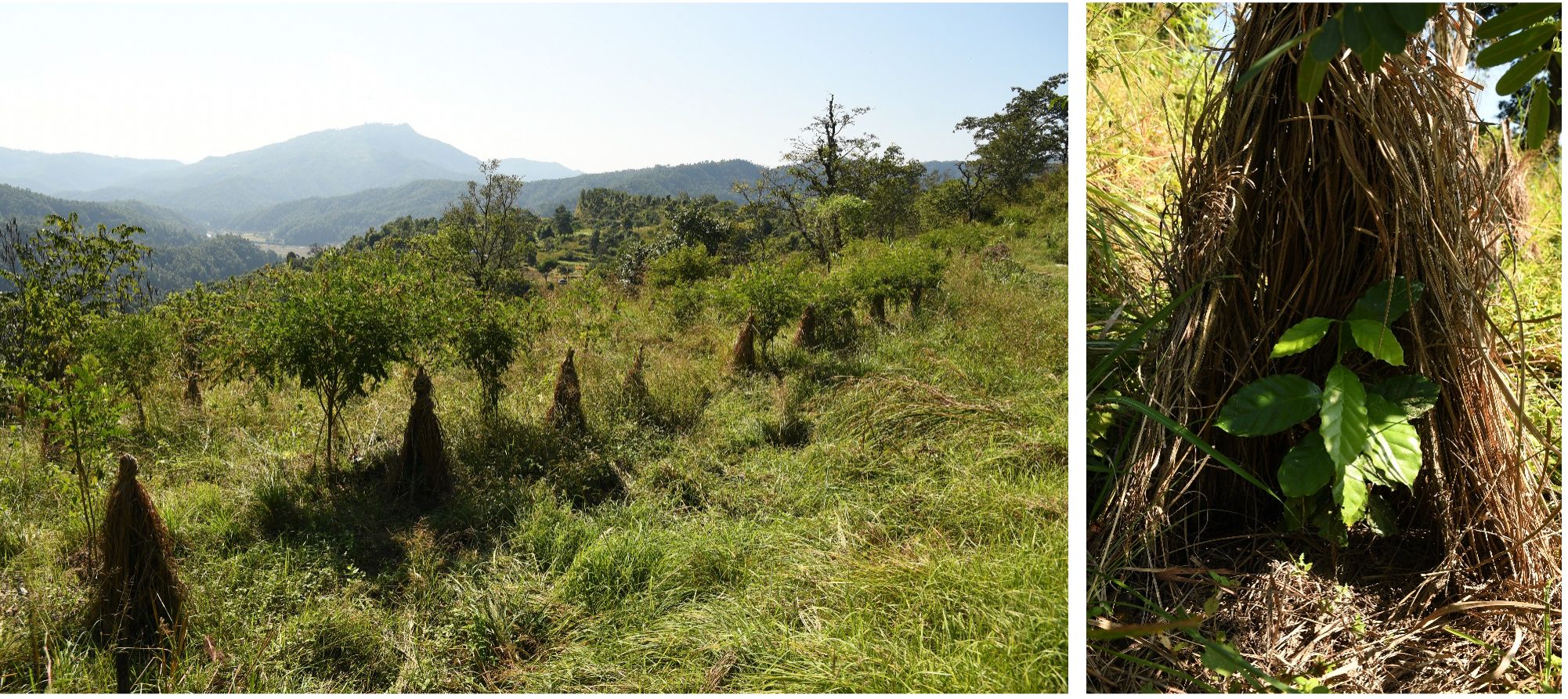
Figure 7: A young row of coffee trees with fast-growing legume shrubs. The coffee plants are still hidden inside the tepees, protected from intense direct sunlight (left). Close-up of a coffee seedling under a tepee made from grass cuttings and bamboo (right).
Despite these unexpected challenges, our monitoring and early data collection showed promising results. Most of the fruit trees established well, the lentils planted between the coffee rows were nearly ready for harvest, and the broomgrass was also growing successfully. Some of the coffee plants, however, struggled to adapt to the site’s specific conditions. We decided that a portion of the seedlings would need to be replanted in the next planting season (2024).
Looking back on 2023, the transformation of these long-abandoned fields into a carbon farming research site was remarkable. We planted thousands of trees, introduced a barcode-based system for individual tree monitoring, and laid the foundation for a long-term study on carbon sequestration. The initial data collected in October 2023 showed that the amount of carbon stored in the young seedlings was still minuscule. However, since tree growth follows an exponential function in the early years, the groundwork was clearly laid for substantial biomass accumulation and carbon storage in the years ahead.
The Second Year (2024)
The first half of 2024 was dedicated to the diligent maintenance of the experimental site. This involved consistent weed control, regular watering, shading, and growth measurements. As the rainy season approached, we seized the opportunity to evaluate our planting strategies from the previous year, implementing adjustments based on our acquired knowledge. While the fruit trees and perennial grasses continued to thrive, the challenges encountered by the coffee trees in 2023 prompted a reassessment of our approach.
Although the Tephrosia shrubs had grown to nearly two meters tall by 2024, planting them simultaneously with the coffee did not provide sufficient early shade.
During the 2024 replanting of coffee trees, we prioritized the health and resilience of the young trees over sheer numbers. A total of 1,500 coffee seedlings were replanted across all plots, utilizing larger planting holes to facilitate better establishment during the critical initial months. We also repurposed our bamboo-and-grass tepee structures to provide essential shade during this early growth phase.
By October 2024, the success of our improved planting method was evident. The newly planted coffee trees were noticeably healthier than the struggling survivors from 2023. Even by the end of the long dry season in May 2025, these young trees were thriving to such an extent that they were already reaching the tops of their original tepees and would soon require taller, more translucent shelters.
The Ratanpur Carbon Farming Experiment remains an ambitious and distinctive project. These first two years demanded significant hard work and to learn from both successes and setbacks. We have confirmed that our sampling, monitoring, and data analysis methods are well-suited for the continuous evaluation. However, we have also learned just how much patience and persistence are required to establish such complex carbon farming systems.
Two years of intense effort have only just begun to manifest in tree growth and initial carbon data. Crucially, these foundational years determine whether a carbon farming system will ultimately flourish and become productive. The initial hurdles have been cleared—now, sustained dedication is paramount.
Reflecting on the challenges we have overcome, I am optimistic about the future. The project is already inspiring tangible change: a farmers’ cooperative in a neighboring village has decided to adopt a similar approach, planting mixed orchards of coffee and fruit trees on their own abandoned fields.
Table 1: Description of the Nine Carbon Farming Systems and Initial Observations
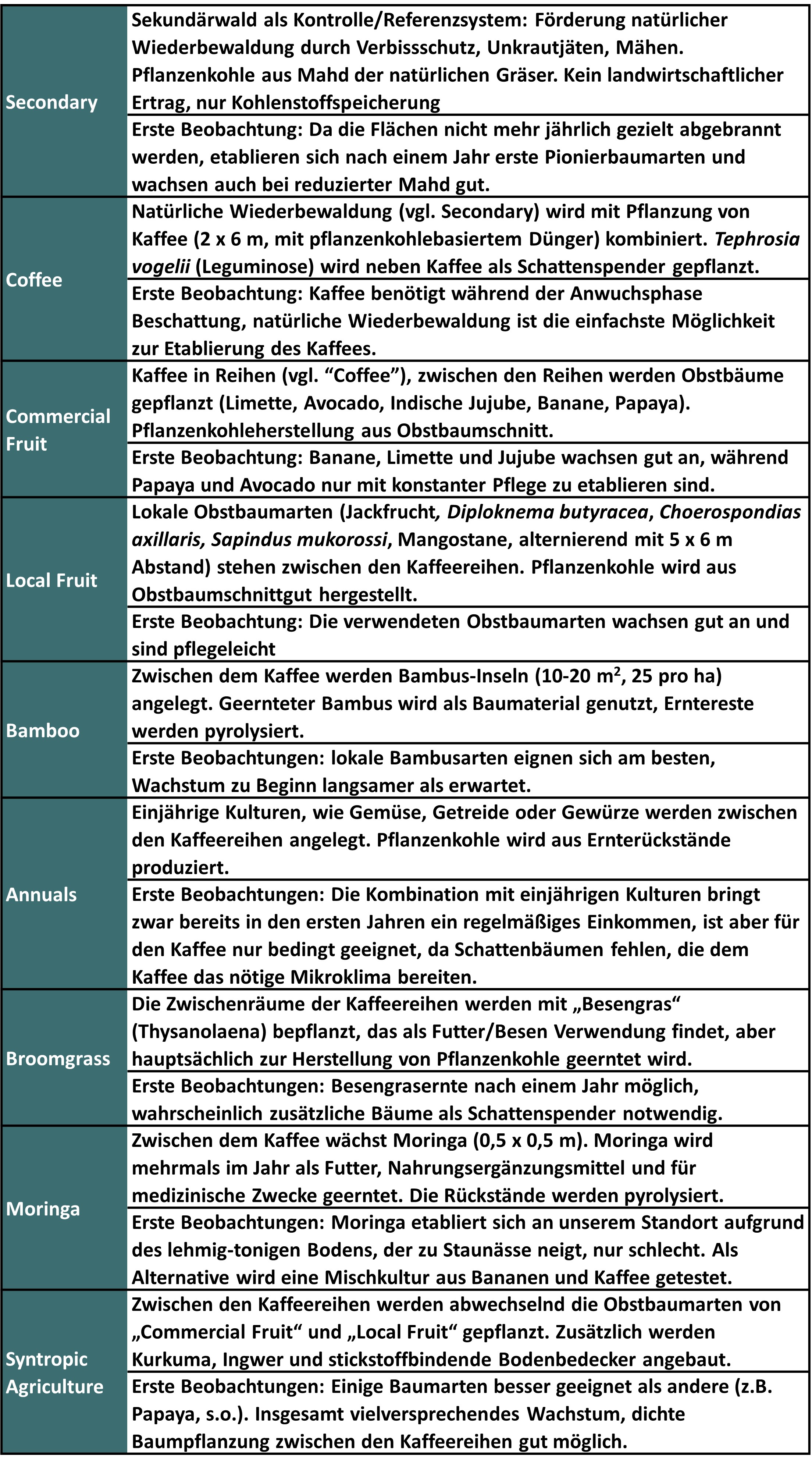

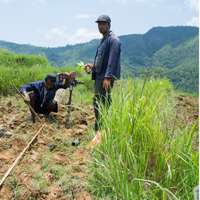
- Please write us your comment -
×